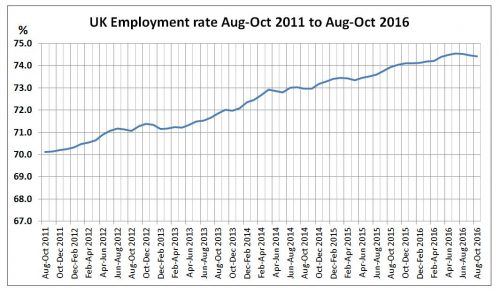Employment growth in the United Kingdom looks like it is beginning to cool down, while unemployment continues to fall, and numbers claiming out of work benefits continue to rise.
Such is the mixed picture revealed by the latest quarterly UK labour market figures from the Office of National Statistics (ONS).
 There are 31.8 million people in work in the UK. Image: pixabay-1836930
There are 31.8 million people in work in the UK. Image: pixabay-1836930
At 31.8 million, the number of people in work remained much the same in August-October 2016 as in the previous quarter.
The employment rate dropped slightly to 74.4 percent – down 0.1 percent from the record high of 74.5 percent of the previous quarter.
At the same time, unemployment dropped by 16,000 during August-October, while the unemployment rate stayed at 4.8 percent – the lowest for 11 years.
However, the number of people claiming out of work benefits has gone up again to the highest level since February 2015.
Brexit beginning to affect labour market
Economists fear these figures show the UK’s Brexit decision to leave the European Union could now be affecting the labour market.
Suren Thiru, head of economics at the British Chambers of Commerce, says:
“The labour market remains a source of strength for the UK economy. The number of people in work remains close to historically high levels, with unemployment levels continuing to fall.”
“However,”, he adds, “there are signs that the UK labour market may be beginning to cool, with a small fall in employment and the continued rise in the claimant count measure.”
He foresees unemployment beginning to drift upwards as uncertainty over Brexit and rising input costs put pressure on businesses and job growth.
Rachel Smith, principal labour market adviser for the Confederation of British Industry (CBI), says:
“We see a mixed picture from the labour market over the last three months, with employment levels remaining more or less the same and unemployment seeing a slight drop.”
 UK employment growth appears to be cooling down. MBN graph of ONS data
UK employment growth appears to be cooling down. MBN graph of ONS data
Wages struggling to get off the ground
In their report on the ONS figures, the CBI and Pertemps Network recruitment specialists highlight that wage growth rose slightly in August-October 2016, with annual regular pay growth reaching 2.6 percent.
“But,” notes the report, “with prices rising at a faster pace, real earnings growth remained flat at 1.7 percent.”
“Although wage growth has gone up somewhat, so has inflation, hitting workers’ pay packets in real terms,” says Smith. “Boosting productivity in every region and nation of the UK will be essential if firms are to further raise wages sustainably for their employees.”
The TUC pick up on this point in their comment on the latest ONS labour market figures. General Secretary Frances O’Grady says:
“Wages are still struggling to get off the ground with increases in pay offset by rising inflation. After the longest wage squeeze since Victorian times, this isn’t the pay boost working people need to get their living standards back on track.”
She urges government to “act fast to avoid another living standards crisis. That means a clear plan for Brexit that will protect jobs, pay and rights.”

